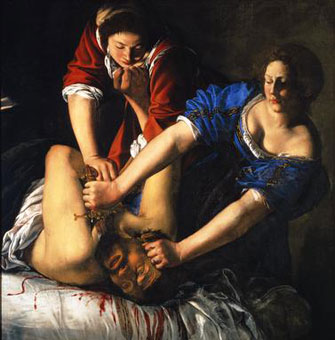An Artistic Caesar in
A Woman’s Body

Artemisia Gentileschi’s ”Judith Slaying Holofernes” (c. 1612). © Fototeca Soprintendenza per il PSAE e per il Polo museale della città di Napoli
The Baroque painter Artemisia Gentileschi (1593-1654) is the subject of a new exhibition at the Musée Maillol with the rather histrionic title “Artemisia: The Power, Glory and Passions of a Female Painter.” The life story and talent of this extraordinary woman may just be dramatic enough to merit it, however.
Perhaps best known as the center of a lengthy trial in Rome in 1612, Artemisia is now taking her proper place in history as the great painter she was. The backstory is that her father, the painter Orazio Gentileschi, accused his colleague Agostino Tassi of raping his 17-year-old daughter and then having a nine-month sexual relationship with her and reneging on his promise of marriage (in fact, he was already married). Tassi was finally condemned to five years of exile as a galley slave (never served), and Artemisia’s father found her another husband, a mediocre painter named Pierantonio Stiattesi.
The most amazing part of the story, however, is that from these scandalous beginnings, Artemisia went on to establish herself as a major painter of her day and an independent woman who lived for varying periods of time in her native Rome, Florence, Naples and London (at the request of King Charles I), ending up on her own with a flourishing workshop in Naples, all of this an impressive achievement at a time when women were considered the property their fathers, brothers and husbands. At the age of only 23, she even became the first woman to be accepted into the Accademia delle Arti del Disegno in Florence, an honor that gave her a number of privileges usually denied to women, including freedom to travel and do business.
Pretty much forgotten a century after her death, the work and life story of Artemisia were resurrected in the early 20th century and later taken up by feminist writers, but her story is still being pieced together, and many gaps remain, making scholarship difficult – few drawings or cartoons of her work have been found, for example, because when the plague devastated Naples beginning in 1656, killing 60 percent of the population, it was thought that the disease was transmitted by paper, so the contents of many ateliers were destroyed.
The exhibition finally offers a rare chance to see a large group of her paintings in one place. A word of warning, however: rather confusingly, the museum has hung the earlier works upstairs and the later, larger works on the ground floor, I suppose because there is more room for the large paintings downstairs. For a clearer view of her career, I would suggest starting upstairs.
You will notice that most of the women in these paintings look alike; that’s because Artemesia used her own beautiful face in many of her works, as a glance at one of the self-portraits makes clear.
You will also notice that not all of the paintings are of equal high quality – this can perhaps be explained by the fact that some may have been partially or fully painted by assistants in her ateliers; the extent of their contributions have not yet been ascertained. There is also still some confusion about whether certain works were painted by Artemisia or her father.
Artemisia had learned Caravaggio’s chiarascuro style from her father, and used it to great effect in some of these paintings. One of the most striking pieces is “Judith Slaying Holofernes” (1612, pictured above), in which a very determined Judith calmly saws off the head of the enemy of Israel with the help of her maid. She almost looks as if she is taking pleasure in a job well done. It has been postulated that the hapless Holofernes rather resembles her rapist Tassi, a nice theory of painting as cathartic revenge therapy. In any case, it makes for a wonderfully dramatic painting. Artemisia zooms in on the scene for a closeup view of Judith, dressed in a sumptuous lapis lazuli dress, while her maid’s red dress echoes the blood streaming onto the white sheet from Holofernes’ neck.
The exhibition includes many paintings of this trio, with others depicting the moment when Judith and her maid, momentarily made social equals by their complicity, are leaving Holofernes’ camp with their trophy – his head – in a basket.
As Mina Gregori points out in her catalog essay, female subjects were popular among private collectors in Artemisia’s day, but hers were no coquettish Venuses contemplating their beauty in a mirror; they were powerful women like Judith, Cleopatra, Bathsheba, Susanna and Jael. In her life, Artemesia didn’t just emulate these heroines, however; this all-conquering woman went so far as to declare that she had “the spirit of Caesar in the body of a woman.”
Let’s hope that as more information becomes known about this fascinating woman, a definitive biography will be written. In the meantime, don’t miss this rare opportunity to see so many of her works in one place.
Musée Maillol: 61, rue de Grenelle, 75007 Paris. Métro: Rue de Bac. Tel.: 01 42 22 59 58. Open daily, 10:30am-7pm (until 9:30pm on Friday). Admission: €11. Through July 15. www.museemaillol.com
Reader Janette Parr writes: “Your readers might like to be reminded about the marvellous film: Artemisia (1997) directed by Agnès Merlet.”
Reader Reaction: Click here to respond to this article (your response may be published on this page and is subject to editing).
Please support Paris Update by ordering books from Paris Update’s Amazon store at no extra cost. Click on your preferred Amazon location: U.K., France, U.S.
More reviews of Paris art shows.
© 2012 Paris Update
Favorite